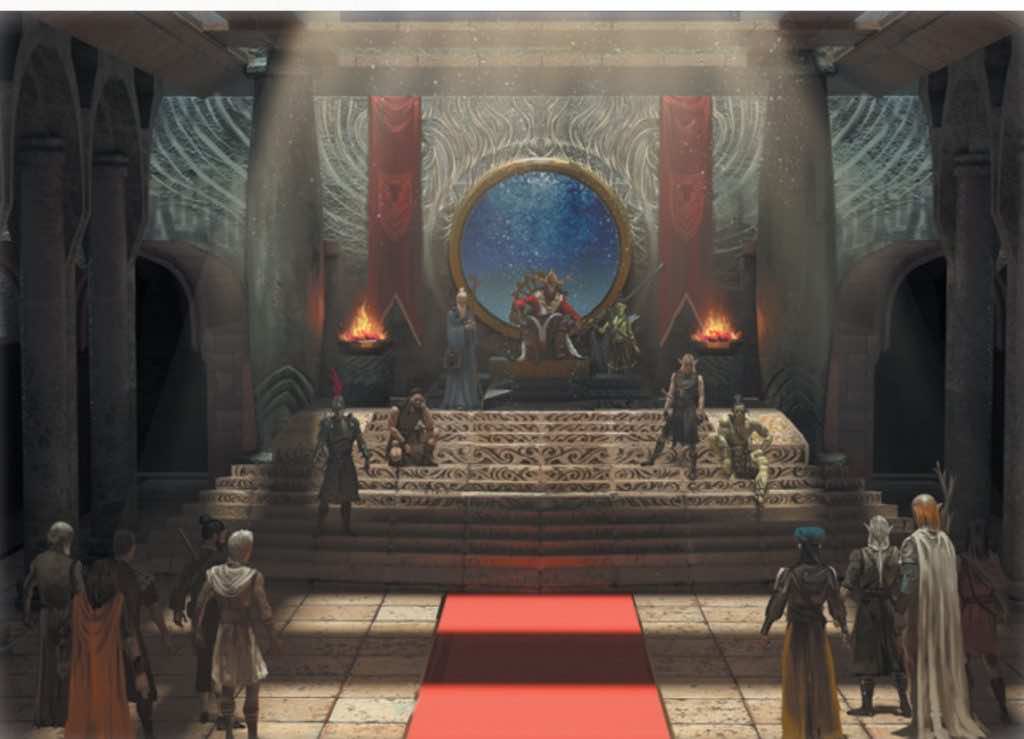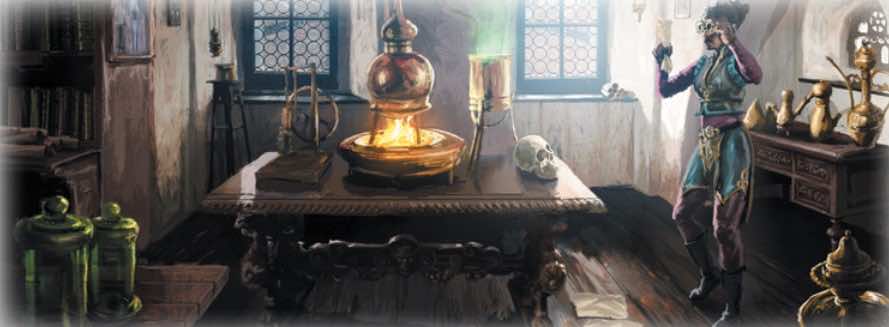Age of Ambition is a role-playing game currently being funded on Kickstarter and produced by Tab Creations LLC. In the last month I have spoken about it both in the announcement article and through an interview with the author. Now I finally have the opportunity to analyze it more deeply and make it better known to you too. This preview is mainly based on the material in the free, downloadable quickstart.
The big picture behind Age of Ambition

Before analyzing Age of Ambition in detail, let’s recap what has already been said. It is a RPG set in a world undergoing transformation. The canons of the classic fantasy must give way to the future, magic must deal with the arrival of technology, the social system must withstand the impact of dissent and the riots of the population. In this scenario, the playing characters place themselves as agents of change, personalities capable of shaping the world in which they live. Will they be able to change things? And will they get what they set for themselves? Will they bear the consequences of their actions? These are some of the questions that could represent the push to undertake an Age of Ambition campaign.
What is the world to change?

The world to change is called Trystell, a moon of a gas giant with a hostile sister moon that has already tried to colonize it once. It is the home of many cultures and many races, including humans, minotaurs, ogres and gnomes.
There are four main deities, some minor deities and a myriad of sects. To these gods are opposed the Ancients, considered the true creators of Trystell and revered only by the Blaugh’ocks, the invaders who came from the other moon.

Magic in this world is present as a measurable and manageable force of nature, according to precise arcane principles. Two forms of magic are known. Kalid magic, the oldest, which extracts energy from dangerous magical creatures called Kalid, whose parts of the body are preserved for future use. Then there is the lunar magic, introduced by the colonizers during the period of occupation by the other moon. It is based on the use of strange devices produced in foundries left by the colonizers.
Of many lands and nations, the quickstart describes four, moving from authoritarian kingdoms to seas infested with pirates and dragons. Up to here we have witnessed the brief description of a pleasant but classic fantasy world. So what boils in the pot that makes it different from everyone else?
Or maybe the world is already changing?
The question is: how are things going in Trystell? For those who live well it is a magnificent period: the evolution of technology and technology allows you to have more food, move faster, generate more energy. The discovery of the press, gunpowder, magnetism and many other wonders frame a magnificent and full of possibilities historical period. But perhaps the people disagree. More food means more children, but not necessarily more work. To survive, you often have to go to cities, where work is hellish and the crime and dirt of the emerging suburbs makes life very difficult. One solution is to seek new uncharted lands beyond known borders, but often it means meeting even worse dead.

This situation cannot last long. The medieval social order is collapsing, conflicts between social classes, between religious ideologies, between fanaticism and between nations are sparks that seem to presage an imminent fire. In that fire the rules of the future society will be shaped, like the borders of the new nations and it will be precisely in that fire that the lives and actions of the characters will shine.
The premises are good. Obviously a few pages cannot do justice to the entire work of world building carried out by the author. In my opinion, a good product is to be expected. Nothing surprising or epochal, but nonetheless a likely and varied basic setting. The spark of change and the idea of an era of transformation are instead beautiful premises, an original and interesting characterization that transforms Age of Ambition into something more captivating.
Saga Machine System: the engine of Age of Ambition
Let’s now briefly analyze the game engine, called the Saga Machine System. It has already been used for previous Tab Creations games, such as Shadow over Sol or Against the Dark Yogi, so it already has an important history behind it.
If usually the description of a game system occupies one or more chapters, with abundant use of paragraphs, columns and tables there will be a reason. Summarizing everything in a few lines is certainly not an easy task, but I will try to give you an idea.

First of all there is the presence, classic, of attributes, skills, specializations, fighting styles and schools of magic, traits and racial traits. Then there are the ambitions, which represent what the character hopes to achieve, a kind of objectives, which also function as a way to gain experience. In my opinion they are an excellent tool to focus a player’s energies towards a specific purpose, characterizing the character and, at the same time, they are an excellent tool for the narrator to understand what his player’s priorities and hopes are. Not for nothing are also present in the name of the game itself.
But let’s get to the real system. It is basically based on two mechanisms: actions and consequences.
It starts with Actions…
For Actions it is simple: base value + card to beat the target number. The value of the numeric cards is that indicated, the value of the figures is based on the character’s Fortune score and the Jokers represent a super critical failure. Very often more than one card is drawn for the mechanics of the Boon & Banes, obtained according to skills or situations. For each Boon you draw one more card and you can choose the best one, for each Bane draws one more card and discards the highest card of all When, through a Boon, cards of the same suit are drawn their values can be added together.

Each player and the master then have a hand of cards available. It represents the luck and the possibility of the characters to influence their fate. Discarding a card during an action gives you an advantage. By discarding it from the right seed, you can add up the value and thus obtain a huge advantage. Until a joker is drawn, however, the cards used by the hand do not replenish, because luck ends for everyone, even for the heroes.
…it continues with Consequences…
The other pillar of the Age of Ambition system are the Consequences, the mechanical effects caused by the actions. The consequences are conditions, altered statuses compared to normality, which usually provide Boons or Banes in Actions. They are of different types and have different durations. For example, Bloody, Wounded, Hidden or Stunned. All names that convey the classic altered states of role-playing games through a simple label system.

The system is not complicated at all. Simple does not mean simplistic, however. It is a light game engine, made to not constantly require consultation of the manual. The Boon & Banes method is simple to apply and master. Ambitions are a brilliant and very useful element and the Consequences allow you to quickly manage the evolution of the events in play and the effects they have on the characters. The use of the deck of cards is a pleasant alternative. Leaving cards in the hands of the players to choose when to assign themselves a bit of luck is a choice that in my opinion is consistent with the type of game and the idea of the role of the characters in Age of Ambition.
…and sometimes you end up in arms!

Combat uses action points and the possibility to choose between taking a fast turn (i.e. acting before the opponents, risking not having more action points to defend) or a slow turn (i.e. acting after the opponents, thus having an idea of how many points stock remained available). The damage is given by the number of the card and bringing the hit points to zero triggers the Consequence “Seriously Wounded” and, subsequently, “Dying”. Consequences can be of any type and invented from one second to the next. They serve to objectify the effects of the story not only on the characters, but on everything. There could be the “Ruined” Consequence on an object like “Grateful” on an entire population.
Then there are a whole list of rules, rather simple, for the management of combat actions, wounds and healing. The rules on magic are hinted at and are placed at roughly the same level of difficulty.
A direct and facilitated access to Age of Ambition
The quickstart ends with an introductory adventure and five pre-generated characters. Some things about magic and equipment related to the characters are explained a little better to allow you to enjoy an almost complete taste of the game.

The adventure itself is fairly trivial. I have to admit that, occupying half of the quickstart and having to serve as a business card for Age of Ambition, I would have tried to present in the game more hooks to the elements that make it different from the others. More politics, more revolution, more change in the air. Instead I felt like I was in a classic introduction of a classic fantasy setting. I am consoled by the fact that at least for me the quality of the introductory adventure is the characteristic that weighs less on the evaluation. Stories can be created, they even come out on their own sometimes during the game. A good system and a credible setting cannot be improvised and, on these two things, the preview I had gave me excellent hopes. I hope to confirm them in a future review!
Keep following us to be updated on Age of Ambition!

